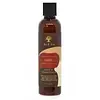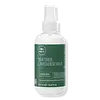What's inside
What's inside
 Key Ingredients
Key Ingredients

 Benefits
Benefits

 Concerns
Concerns

 Ingredients Side-by-side
Ingredients Side-by-side

Water
Skin ConditioningCetearyl Alcohol
EmollientCetyl Alcohol
EmollientCocos Nucifera Fruit Extract
EmollientPhyllanthus Emblica Fruit Extract
HumectantBeta Vulgaris Root Extract
Skin ConditioningPhytosterols
Skin ConditioningSerenoa Serrulata Fruit Extract
Skin ConditioningCamellia Sinensis Leaf Extract
AntimicrobialGlycerin
HumectantPyrus Malus Fruit Extract
Skin ConditioningCitrus Limon Peel Extract
EmollientSaccharum Officinarum Extract
MoisturisingBetaine
HumectantBehentrimonium Methosulfate
Stearamidopropyl Dimethylamine
EmulsifyingCitric Acid
BufferingPhenoxyethanol
PreservativeCaprylyl Glycol
EmollientPotassium Sorbate
PreservativePolyacrylamide
Parfum
MaskingAnise Alcohol
PerfumingCoumarin
PerfumingLimonene
PerfumingWater, Cetearyl Alcohol, Cetyl Alcohol, Cocos Nucifera Fruit Extract, Phyllanthus Emblica Fruit Extract, Beta Vulgaris Root Extract, Phytosterols, Serenoa Serrulata Fruit Extract, Camellia Sinensis Leaf Extract, Glycerin, Pyrus Malus Fruit Extract, Citrus Limon Peel Extract, Saccharum Officinarum Extract, Betaine, Behentrimonium Methosulfate, Stearamidopropyl Dimethylamine, Citric Acid, Phenoxyethanol, Caprylyl Glycol, Potassium Sorbate, Polyacrylamide, Parfum, Anise Alcohol, Coumarin, Limonene
Water
Skin ConditioningPropylene Glycol
HumectantCetyl Alcohol
EmollientBehentrimonium Chloride
PreservativePhenyl Trimethicone
Skin ConditioningMelaleuca Alternifolia Leaf Oil
AntioxidantLavandula Angustifolia Extract
Skin ConditioningMentha Spicata Flower/Leaf/Stem Extract
MaskingPanthenol
Skin ConditioningTocopheryl Acetate
AntioxidantQuaternium-80
Dimethicone
EmollientDisodium EDTA
Ethylhexylglycerin
Skin ConditioningIsopropyl Alcohol
SolventTocopherol
AntioxidantPhenoxyethanol
PreservativeParfum
MaskingLinalool
PerfumingBenzyl Alcohol
PerfumingLimonene
PerfumingBenzyl Benzoate
AntimicrobialWater, Propylene Glycol, Cetyl Alcohol, Behentrimonium Chloride, Phenyl Trimethicone, Melaleuca Alternifolia Leaf Oil, Lavandula Angustifolia Extract, Mentha Spicata Flower/Leaf/Stem Extract, Panthenol, Tocopheryl Acetate, Quaternium-80, Dimethicone, Disodium EDTA, Ethylhexylglycerin, Isopropyl Alcohol, Tocopherol, Phenoxyethanol, Parfum, Linalool, Benzyl Alcohol, Limonene, Benzyl Benzoate
 Reviews
Reviews

Ingredients Explained
These ingredients are found in both products.
Ingredients higher up in an ingredient list are typically present in a larger amount.
Cetyl Alcohol is a fatty alcohol. Fatty Alcohols are most often used as an emollient or to thicken a product.
Its main roles are:
Though it has "alcohol" in the name, it is not related to denatured alcohol or ethyl alcohol.
The FDA allows products labeled "alcohol-free" to have fatty alcohols.
Learn more about Cetyl AlcoholLimonene is a fragrance that adds scent and taste to a formulation.
It's found in the peel oil of citrus fruits and other plants such as lavender and eucalyptus. The scent of limonene is generally described as "sweet citrus".
Limonene acts as an antioxidant, meaning it helps neutralize free radicals.
When exposed to air, oxidized limonene may sensitize the skin. Because of this, limonene is often avoided by people with sensitive skin.
The term 'fragrance' is not regulated in many countries. In many cases, it is up to the brand to define this term. For instance, many brands choose to label themselves as "fragrance-free" because they are not using synthetic fragrances. However, their products may still contain ingredients such as essential oils that are considered a fragrance.
Learn more about LimoneneParfum is a catch-all term for an ingredient or more that is used to give a scent to products.
Also called "fragrance", this ingredient can be a blend of hundreds of chemicals or plant oils. This means every product with "fragrance" or "parfum" in the ingredients list is a different mixture.
For instance, Habanolide is a proprietary trade name for a specific aroma chemical. When used as a fragrance ingredient in cosmetics, most aroma chemicals fall under the broad labeling category of “FRAGRANCE” or “PARFUM” according to EU and US regulations.
The term 'parfum' or 'fragrance' is not regulated in many countries. In many cases, it is up to the brand to define this term.
For instance, many brands choose to label themselves as "fragrance-free" because they are not using synthetic fragrances. However, their products may still contain ingredients such as essential oils that are considered a fragrance by INCI standards.
One example is Calendula flower extract. Calendula is an essential oil that still imparts a scent or 'fragrance'.
Depending on the blend, the ingredients in the mixture can cause allergies and sensitivities on the skin. Some ingredients that are known EU allergens include linalool and citronellol.
Parfum can also be used to mask or cover an unpleasant scent.
The bottom line is: not all fragrances/parfum/ingredients are created equally. If you are worried about fragrances, we recommend taking a closer look at an ingredient. And of course, we always recommend speaking with a professional.
Learn more about ParfumPhenoxyethanol is a preservative that has germicide, antimicrobial, and aromatic properties. Studies show that phenoxyethanol can prevent microbial growth. By itself, it has a scent that is similar to that of a rose.
It's often used in formulations along with Caprylyl Glycol to preserve the shelf life of products.
Water. It's the most common cosmetic ingredient of all. You'll usually see it at the top of ingredient lists, meaning that it makes up the largest part of the product.
So why is it so popular? Water most often acts as a solvent - this means that it helps dissolve other ingredients into the formulation.
You'll also recognize water as that liquid we all need to stay alive. If you see this, drink a glass of water. Stay hydrated!
Learn more about Water